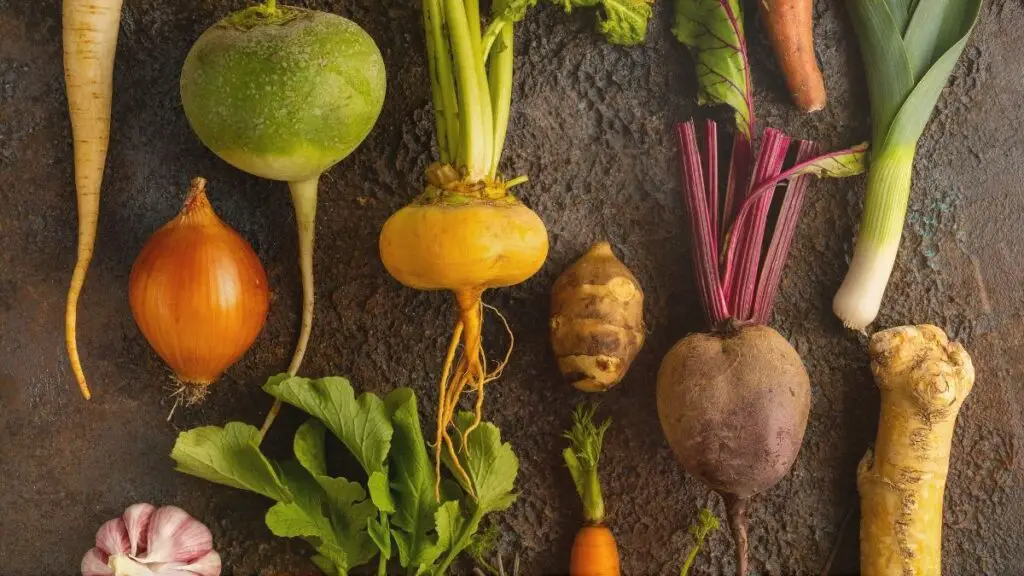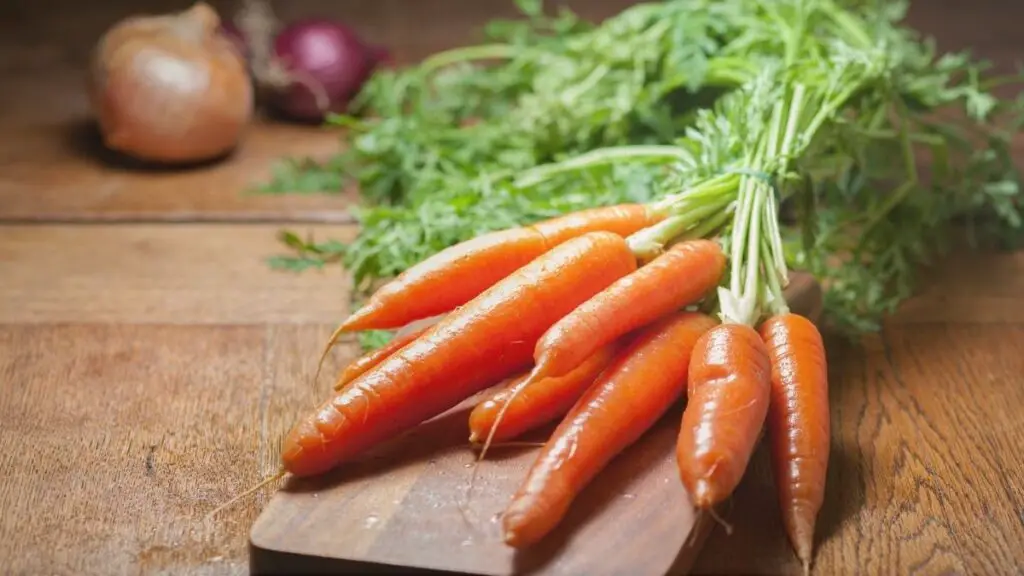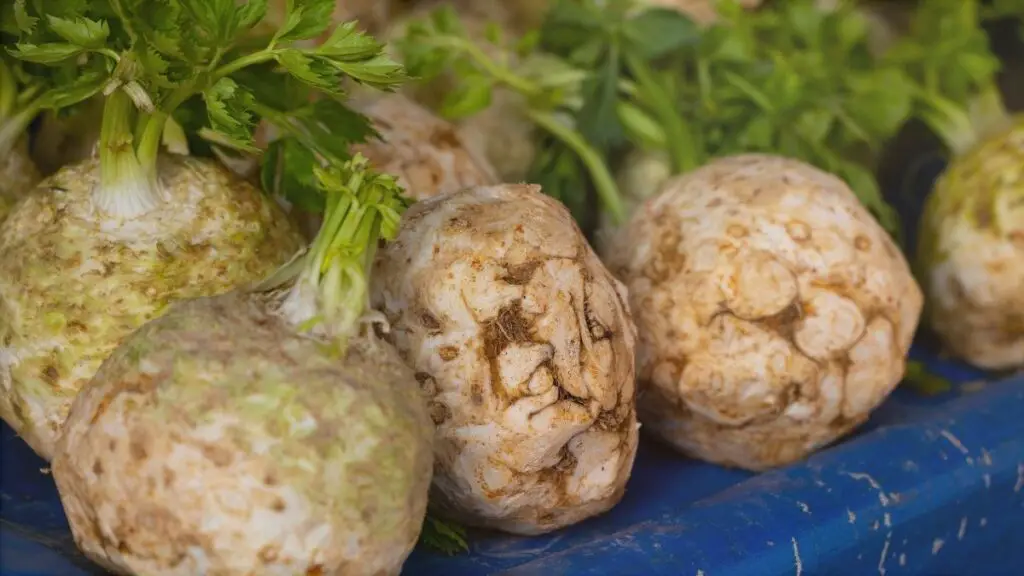
How often do you hear that you need to eat more vegetables? There’s a reason that people talk about vegetables in glowing terms in culinary circles and in health-conscious settings.
No wonder! They’re packed with antioxidants and anti-inflammatory compounds that help fight low-grade inflammation.
The inflammation-fighting power of veggies sounds like an ally if you have histamine intolerance.
Many plant-based foods are low in histamine and may even help your body better clear histamine, though there are high-histamine exceptions like avocados, spinach, and tomatoes-
One group of vegetables popular in the winter are root vegetables. As the weather gets colder, people tend to gravitate more toward root veggies.
You might wonder whether there are low-histamine root vegetables that are safe to add to your plate?
Over the years, I’ve seen patients thrive when they swap out high-histamine foods for these underground staples that are packed with nutrition.

Carrots: Your Beta-Carotene Ally
Bugs Bunny made carrots popular, and he knew a good thing when he saw it. Carrots are packed with beta-carotene, an antioxidant and a precursor to vitamin A.
When you consume beta-carotene rich foods, which are often orange in color, your body converts a portion of that beta-carotene to vitamin A.
The combo of beta-carotene and vitamin helps support the health of your immune system and visual system while keeping inflammation in check.
Best of all, they are low in histamine and shouldn’t worsen histamine intolerance symptoms. But do yourself a favor and keep a food journal.

Sweet Potatoes: Comfort Food with Benefits
I remember a patient who missed comfort foods after cutting out aged cheeses and tomatoes. For her the natural sweetness of sweet potatoes filled that gap.
Plus, she was getting the benefits of the beta-carotene in sweet potatoes. That’s not surprising since, like carrots, they’re orange.
Plus, sweet potatoes are jam-packed with fiber and other antioxidants, including vitamin C. Like carrots, they increase your vitamin A level.
Would you believe that just one medium sweet potato meets an adult’s vitamin A needs for a day?
Roast them, mash them, or spiralize them. Whether you crave them pureed or cooked to a high heat in the oven, this orange root vegetable is a low-histamine favorite, especially around the holidays.
And get this. When you pair carrots and sweet potatoes with a healthy and low-histamine source of fat, you’ll absorb their beta-carotene more efficiently.

Beets: Earthy and Cardiovascular-Friendly
A few years ago, I talked to a patient with mast cell activation syndrome struggled with fatigue. She started eating beets daily and drinking beet root juice. After a few weeks of doing this, she said she felt more energized and had less brain fog.
She also noticed a drop in blood pressure. That’s not surprising, as beets contain nitrates that your body converts to nitric oxide, a natural gas that dilates blood vessels and helps lower blood pressure and increase blood flow to your muscles and tissues.
In addition, their fiber supported her gut health, which directly influences histamine metabolism. You can grate beetroot raw into salads or roast them for depth of flavor.
If you have a history of calcium oxalate kidney stones, avoid eating beets or drinking beet root juice. Beets also contain oxalates that contribute to kidney stones. Also, some people are sensitive to oxalates and should avoid them.
But as far as histamine goes, beets fall into the class of low-histamine root vegetables.
Radishes: Crisp and Cooling
If you question people about their favorite veggies, radishes will rarely make the list. One woman told me she thought they were “too sharp.”
But when she added them to salads, she realized they gave her meals freshness without upsetting her histamine balance.
Plus, they’re rich in antioxidants, like vitamin C and their folate content that helps your liver better break down toxins through methylation, the process of adding a methyl group to a molecule.
This is the way your body breaks down environmental chemicals, excess hormones, and metabolic byproducts.

Parsnips: Sweet Winter Energy
Parsnips shine in colder months and for good reason! Their complex carbohydrates, combined with fiber, give your body steady fuel without histamine spikes. They also bring folate, vitamin C, and vitamin K to your plate.
If you’re worried about triggering histamine intolerance symptoms, you can relax. Parsnips make the list of low-histamine root vegetables because they’re unlikely to raise your body’s histamine load.
If you’re unsure how to prepare them, try the Martha Stewart approach:
- Coat parsnips in olive oil.
- Season lightly with low-histamine herbs and salt.
- Roast at high heat and allow their natural sugars to caramelize and unveil their sweetness.
And here’s a fast fact for you. Before you could buy bags of cane sugar, people often used parsnips as a sweetener when baking.

Celeriac: Aromatic and Versatile
You don’t hear a lot about celeriac, but it’s a low-histamine root vegetable that’s high in nutrients. It contains antioxidants and compounds that help fight inflammation.
Plus, the fiber content helps support the health of your gut microbiome – and you know how important it is to have a diverse gut ecosystem.
You can toss raw celeriac into salads or pureed and use it to thicken and add more nutrients to soup. Its earthy, aromatic flavor adds depth without relying on high-histamine seasonings.

Turnips: Humble but Reliable
When you buy fresh turnips, you’re getting a low-histamine root vegetable. Although you might not enjoy them raw, cooking turns their bitter flavor into a gentle sweetness.
Like other root vegetables, they contain potassium, folate and antioxidants that help support cellular health.
If you think you don’t like the taste of turnips, try roasting them. The high heat turns their natural sugars into nutty sweetness. But use them right after buying them. If you store cooked turnips, they can produce amines over time.
Potatoes: The Classic Staple
Potatoes are a low-histamine root vegetable when you buy them fresh and use them quickly. I’ve seen patients run into trouble reheating leftovers, which can accumulate histamine.
But when you don’t let them sit, tubers provide complex carbs, vitamin C, and potassium and won’t add to your body’s histamine burden.
Plus, there are so many ways to prepare them! Potatoes are one of the best sources of potassium, which is vital for heart and blood vessel health.
Preparation Matters
How you prepare root vegetables makes all the difference. Buy root vegetables fresh, store them in cool, dry places, and cook them as soon as you can. Buy fresh whole root vegetables.
Once you get them home, store them in cool, dry conditions to minimize oxidation and bacterial colonization that can trigger histamine formation.
And it might sound convenient but avoid pre-cut vegetables of all types. Cutting exposes more surface area for microbes to grow, ferment and produce histamine.
Supporting Histamine Metabolism
Root vegetables don’t just stay low in histamine—they help your body break it down. Nutrients like vitamin B6, vitamin C, magnesium, zinc, copper, and manganese support diamine oxidase (DAO), the enzyme that degrades the histamine that triggers histamine intolerance symptoms.
Carrots and sweet potatoes supply vitamin C and beta-carotene, while others contribute B vitamins and minerals.
Conclusion
As a physician, I’ve also used AI tools to help people personalize their diets. I do this by matching their symptoms with food choices and seeing how they respond.
You can take the same approach: choose fresh root vegetables, prepare them thoughtfully, and let them support your health while you keep a food journal to see how your body responds to low-histamine root vegetables.
References:
- McLean A. 13 Healthy Root Vegetables and Their Benefits. Healthline. Published June 29, 2023. Accessed November 18, 2025. https://www.healthline.com/nutrition/root-vegetables#turmeric
- Hrubisko M, Danis R, Huorka M, Wawruch M. Histamine Intolerance—The More We Know the Less We Know. A Review. Nutrients. 2021;13(7):2228-2228. doi:https://doi.org/10.3390/nu13072228.
- Low Histamine Diet. https://www.hopkinsmedicine.org/-/media/johns-hopkins-childrens-center/documents/specialties/adolescent-medicine/cfs-low-histamine-diet.pdf
- Jia Y, Liu Y, Wu Y, Ren F, Liu H. From diet to microbiota: how fruits and vegetables influence gut microbiota. International Journal of Food Science & Technology. 2025;60(1). doi:https://doi.org/10.1093/ijfood/vvae008.
- The Beet Goes On: A Natural Boost for Aging Blood Vessels. American Council on Science and Health. Published 2025. Accessed November 18, 2025. https://www.acsh.org/news/2025/07/28/beet-goes-natural-boost-aging-blood-vessels-49641.
- Ma H, Liu H, Yang Y, Han M, Jiang C. The effect of folate deficiency and different doses of folic acid supplementation on liver diseases. British Journal of Nutrition. 2024;133(1):37-47. doi:https://doi.org/10.1017/s000711452400285x

